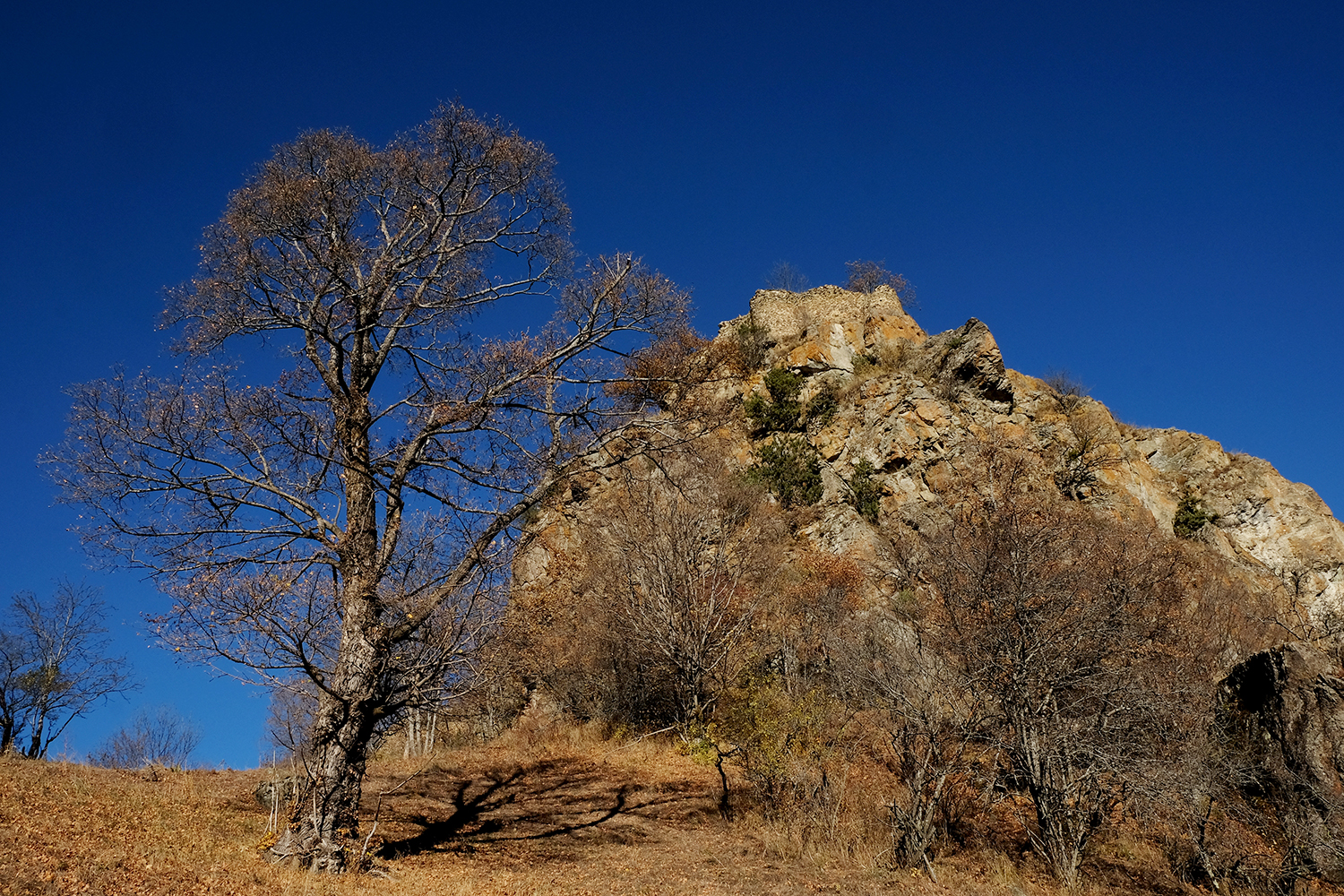Handaberd is a striking medieval castle high in the mountains of the Tzar region of Artsakh, near the village of Chapni. This impressive fortress was designed to keep visitors out, yet its impressive walls and towers beckon you to come inside and explore. The castle, one of the largest and best preserved in Artsakh, transports you back to the feudal world of the middle ages, where princes, knights, and sieges were very much the norm. Nearby, an equally majestic monastery associated with the castle reminds us that these were not just secular princes, but pious warriors defending their Christian faith. Even centuries later, the secular and spiritual strength of the princes that lived here fills Handaberd with palpable power.
Royal Blood
The fortress of Handaberd was home to Armenian royalty for hundreds of years–its importance is recorded in medieval histories from the 9th century until at least 1250. The central citadel was built by Artnerseh of the Aranshahik dynasty sometime before 854, possibly on the remains of an earlier fortress occupied by his ancestors. Artnerseh’s castle was a modest construction, only 300 square meters, but the walls grew dramatically overtime to 5520 meters, nearly 20x their original size. The expansion of Handaberd perhaps took place under the reign of Hasan Vakhtanghian, the ruling prince of Upper Khachen from 1142-1182. His occupation of the fortress was noteworthy enough to be recorded at the nearby and renowned monastery of Dadivank, on a khachkar (cross-stone). Handaberd later passed into the hands of the Dopian principality, who perhaps retained control into the 16th century.
Safety First
Security was of utmost importance at Handaberd. The castle itself is located on a vertical rocky slope, 280 meters above a river. The main entrance was only accessible via a narrow path along the rocks beneath the southwestern wall. Any enemies trying to approach the castle would be on uneven ground, and the defenders of Handaberd would, quite literally, have the upper hand. Along the narrow path to the castle was a hidden shelter, completely carved out of the mountain rock, in which soldiers could hide and ambush enemy forces. To further disadvantage potential adversaries, the castle has a series of false entrances, as well as eight tall towers from which Handaberd’s soldiers could safely stage their counterattacks. There are also a series of watchtowers along neighboring mountain peaks to keep an eye on Handaberd and forewarn its forces of an incoming attack. These watchtowers, such as the one still standing on Mount Pahak, provide an important example of the military defense networks operating in the Caucasus in the medieval period.
Other, more subtle aspects of Handaberd’s architecture also point to an emphasis on security. The walls alone are never less than 1.3 meters thick, and they reach an imposing 8 meters in height. More defensive protections are found inside the castle walls. Directly behind the walls are six deep pits for storing water in case of an extended siege. A citadel within the castle adds further protection for the princes of Handaberd and their families. This smaller structure may be as old as the 5th century and demonstrates the longevity and stability of this well-defended fortress.
A Place for Prayer
Less than a kilometer east of Handaberd stand the ruins of the castle’s royal monastery, aptly named Handaberdi Vank, which in Armenian means “Monastery of Handaberd.” Unlike the castle, which is located high on a defensible slope, the monastery is in the middle of a valley with wooded hills all around. This arrangement was not unusual in the Armenian Caucasus, where monasteries were often coupled with secular fortresses for protection as well as patronage. The primary structure at the monastery is a church with an unusually large octagonal dome that covers the vast interior. Beneath the dome, fragments of frescoes recall the colorful decoration churchgoers enjoyed in the medieval period. The interior of the church also bears a fragmentary inscription from a certain “Sasn,” who appears to have been the patron of this church and possibly other smaller churches at the monastery that have not survived. Other features of Handaberdi Vank include a small chapel accessed through the north wall of the main church interior, and a free-standing belltower off to the north-west. The foundation inscription, on the western wall of the belltower, indicates it was built in 1276 by Davit, in commemoration of a local victory. Davit’s inscription goes on to invoke God’s wrath upon whoever may destroy the tower, again referencing the tumultuous climate of the region and the benefit of Handaberd castle nearby.
In and around Handaberd castle and monastery, inscriptions testify to the pious patrons of both sites. As at many medieval Armenian sites, the majority of these inscriptions are recorded on intricately carved khachkars, which serve as a kind of stony historical document. At the castle, a khachkar from 1196 implores passers-by to pray in the memory of a son named Khosrov. A particularly intricate khachkar at the monastery features a bird inside a labyrinth, beneath a cross surrounded by grapevines; on the bottom, on either side of the bird, Vasak, grandson of Harb, asks us to remember and pray for his mother. Elsewhere at the monastery khachkars tell us of the prayers of Jalab and his brother Khapl in 1194, Ar in 1197, and Grigor in an unknown year. On the very edge of Handaberdi Vank stands the gravestone of Stepanos, the Catholicos, or ecclesiastical patriarch, of this region from 1262-1323.
The multitude and variety of inscriptions at both the castle and monastery of Handaberd remind us that these sites were an integral part of the medieval Armenian landscape for hundreds of years. People lived and died at these sites, and their memories still mark the monuments we see today.
